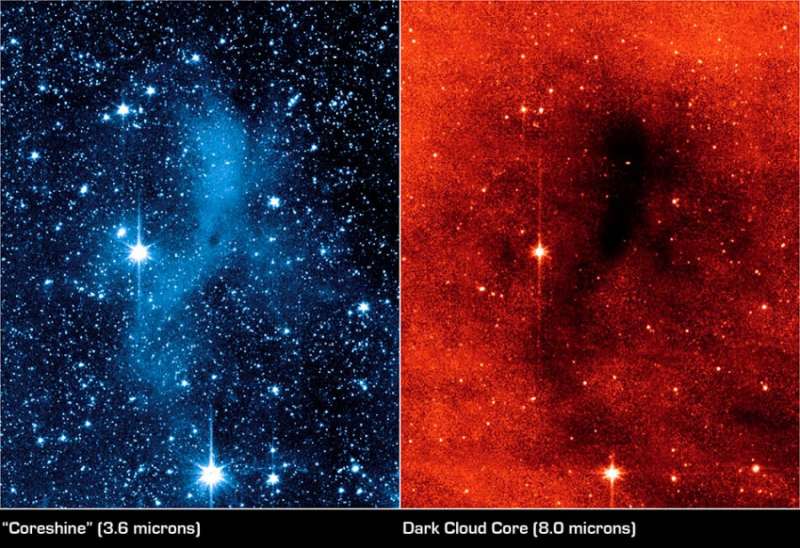
|
Credit & Copyright: NASA,
JPL-Caltech,
Laurent Pagani (Obs.Paris/CNRS),
Jurgen Steinacker (Obs. Paris/MPIA)
et al.
Explanation:
Stars and their planets
are born in cold, dark, interstellar
clouds of gas and dust.
While exploring the clouds at
infrared wavelengths,
astronomers have made a surprising discovery -- dozens of cases
where dense cloud cores shine by reflecting
infrared starlight.
Based on archival
Spitzer Space Telescope
data, these panels illustrate the newly described phenomenon,
known as coreshine.
At longer infrared wavelengths (right) the core of
cloud Lynds 183
is dark, but at shorter infrared wavelengths
(left) the core clearly shines,
scattering light
from nearby stars.
As seen in these panels, the elongated core covers a mere 1.5 light-years.
The scattering requires dust grains that are about 10 times
larger than previously thought to exist in the clouds,
about 1 micron in size instead of 0.1 micron.
For comparison, a human hair is about 100 microns thick.
The larger dust grains indicated by coreshine could
change models of the early phases of star and planet formation,
a still mysterious process hidden
within the interstellar clouds.
Dark nebula Lynds 183 lies around
325 light-years away in the constellation Serpens.
|
January February March April May June July August September October November December |
| ||||||||||||||||||||||||||||||||||||||||||||||||
NASA Web Site Statements, Warnings, and Disclaimers
NASA Official: Jay Norris. Specific rights apply.
A service of: LHEA at NASA / GSFC
& Michigan Tech. U.
Based on Astronomy Picture
Of the Day
Publications with keywords: infrared - Spitzer space telescope - star formation - molecular cloud
Publications with words: infrared - Spitzer space telescope - star formation - molecular cloud
See also:
- APOD: 2025 August 1 Á Small Dark Nebula
- APOD: 2025 July 10 Á Lynds Dark Nebula 1251
- APOD: 2025 June 23 Á W5: Pillars of Star Formation
- APOD: 2025 April 28 Á Gum 37 and the Southern Tadpoles
- APOD: 2025 March 26 Á Star Formation in the Pacman Nebula
- The Protostars within Lynds 483
- APOD: 2025 February 23 Á Saturn in Infrared from Cassini
